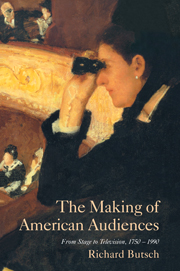Book contents
- Frontmatter
- Contents
- Acknowledgments
- Introduction: Participative Public, Passive Private?
- 1 Colonial Theater, Privileged Audiences
- 2 Drama in Early Republic Audiences
- 3 The B'Hoys in Jacksonian Theaters
- 4 Knowledge and the Decline of Audience Sovereignty
- 5 Matinee Ladies: Re-gendering Theater Audiences
- 6 Blackface, Whiteface
- 7 Variety, Liquor, and Lust
- 8 Vaudeville, Incorporated
- 9 “Legitimate” and “Illegitimate” Theater around the Turn of the Century
- 10 The Celluloid Stage: Nickelodeon Audiences
- 11 Storefronts to Theaters: Seeking the Middle Class
- 12 Voices from the Ether: Early Radio Listening
- 13 Radio Cabinets and Network Chains
- 14 Rural Radio: “We Are Seldom Lonely Anymore”
- 15 Fears and Dreams: Public Discourses about Radio
- 16 The Electronic Cyclops: Fifties Television
- 17 A TV in Every Home: Television “Effects”
- 18 Home Video: Viewer Autonomy?
- 19 Conclusion: From Effects to Resistance and Beyond
- Appendix: Availability, Affordability, Admission Price
- Notes
- Selected Bibliography
- Index
- Plate section
19 - Conclusion: From Effects to Resistance and Beyond
Published online by Cambridge University Press: 05 June 2012
- Frontmatter
- Contents
- Acknowledgments
- Introduction: Participative Public, Passive Private?
- 1 Colonial Theater, Privileged Audiences
- 2 Drama in Early Republic Audiences
- 3 The B'Hoys in Jacksonian Theaters
- 4 Knowledge and the Decline of Audience Sovereignty
- 5 Matinee Ladies: Re-gendering Theater Audiences
- 6 Blackface, Whiteface
- 7 Variety, Liquor, and Lust
- 8 Vaudeville, Incorporated
- 9 “Legitimate” and “Illegitimate” Theater around the Turn of the Century
- 10 The Celluloid Stage: Nickelodeon Audiences
- 11 Storefronts to Theaters: Seeking the Middle Class
- 12 Voices from the Ether: Early Radio Listening
- 13 Radio Cabinets and Network Chains
- 14 Rural Radio: “We Are Seldom Lonely Anymore”
- 15 Fears and Dreams: Public Discourses about Radio
- 16 The Electronic Cyclops: Fifties Television
- 17 A TV in Every Home: Television “Effects”
- 18 Home Video: Viewer Autonomy?
- 19 Conclusion: From Effects to Resistance and Beyond
- Appendix: Availability, Affordability, Admission Price
- Notes
- Selected Bibliography
- Index
- Plate section
Summary
Surveys of communication research have characterized the history of the field as a movement from conceiving audiences as passive to seeing them as active. As we have seen, the image of audiences as passive victims arose from countless articles in the popular press expressing fears about new mass media. Reformers, educators, clergy, and other human service professionals wrote extensively about the dangers of movies, radio, and television, as each became popular. Intellectuals and cultural critics blamed these media for the decline in culture. They expressed little faith in the average person's ability to manage mass media and, in the spirit of mass culture criticism, characterized the masses as in danger of becoming helpless victims.
Communication researchers typically have shaped their agenda to answer and allay these public concerns. Research reports often began by quoting magazine claims of the dangers of mass media and then proceeded to answer these fears with reassuring research results that the effects were not so serious. The Payne Fund researchers in the 1930s began with their benefactor's fears about effects of movies on children, but reported less extreme results, and even objected to stronger statements made in the project's final report. Early propaganda studies similarly were prompted by a popular “hypodermic theory” that propaganda simply injected ideas into its audiences.
- Type
- Chapter
- Information
- The Making of American AudiencesFrom Stage to Television, 1750–1990, pp. 280 - 294Publisher: Cambridge University PressPrint publication year: 2000



